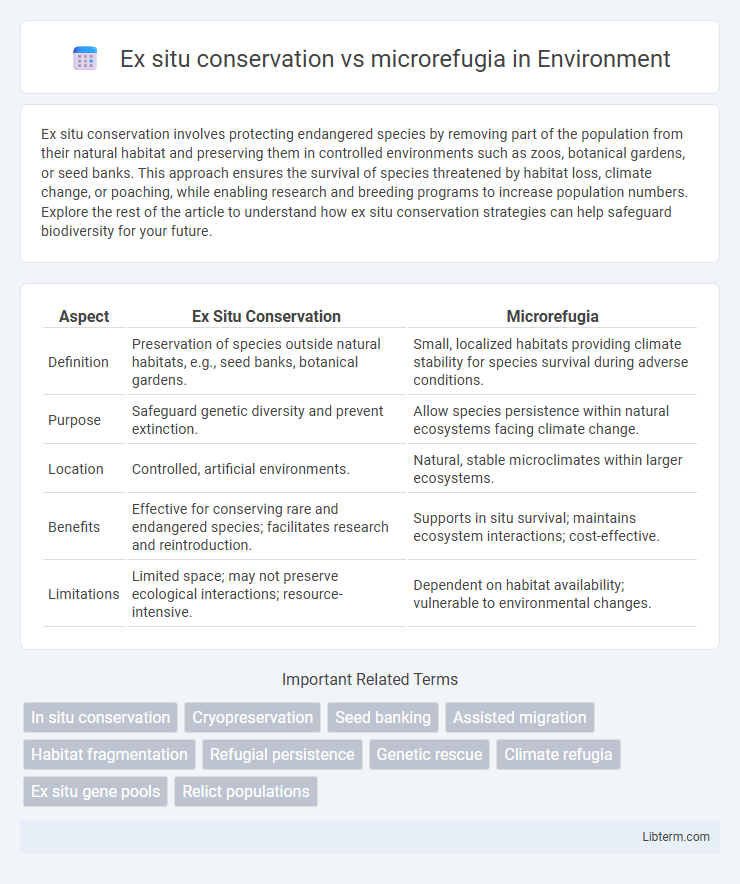Ex situ conservation involves protecting endangered species by removing part of the population from their natural habitat and preserving them in controlled environments such as zoos, botanical gardens, or seed banks. This approach ensures the survival of species threatened by habitat loss, climate change, or poaching, while enabling research and breeding programs to increase population numbers. Explore the rest of the article to understand how ex situ conservation strategies can help safeguard biodiversity for your future.
Table of Comparison
| Aspect | Ex Situ Conservation | Microrefugia |
|---|---|---|
| Definition | Preservation of species outside natural habitats, e.g., seed banks, botanical gardens. | Small, localized habitats providing climate stability for species survival during adverse conditions. |
| Purpose | Safeguard genetic diversity and prevent extinction. | Allow species persistence within natural ecosystems facing climate change. |
| Location | Controlled, artificial environments. | Natural, stable microclimates within larger ecosystems. |
| Benefits | Effective for conserving rare and endangered species; facilitates research and reintroduction. | Supports in situ survival; maintains ecosystem interactions; cost-effective. |
| Limitations | Limited space; may not preserve ecological interactions; resource-intensive. | Dependent on habitat availability; vulnerable to environmental changes. |
Introduction to Ex Situ Conservation and Microrefugia
Ex situ conservation involves preserving species outside their natural habitats, such as in seed banks, botanical gardens, and captive breeding programs, ensuring genetic diversity and safeguarding against extinction. Microrefugia are small, localized areas where species survive unfavorable climatic conditions, providing critical natural shelters that maintain biodiversity during environmental changes. Understanding these strategies highlights the balance between artificial preservation and natural resilience essential for effective biodiversity conservation.
Defining Ex Situ Conservation Strategies
Ex situ conservation strategies involve preserving genetic material, species, or populations outside their natural habitats, typically through seed banks, botanical gardens, or cryopreservation. These methods enable the safeguarding of biodiversity by maintaining viable specimens under controlled conditions to prevent genetic erosion. Microrefugia differ by focusing on protecting small, localized habitats that serve as climate shelters for species, but ex situ strategies are essential for species unable to survive in situ or microrefugia during extreme environmental changes.
Understanding the Concept of Microrefugia
Microrefugia are small, localized areas where populations of species persist through adverse climate conditions, providing critical natural refuges that support biodiversity and genetic diversity in situ. Unlike ex situ conservation, which involves relocating species to controlled environments such as botanical gardens or seed banks, microrefugia enable species to survive within their native habitats by buffering against environmental changes at a microclimatic scale. Understanding microrefugia involves recognizing their role in maintaining evolutionary processes and facilitating species resilience amid climate change through natural habitat preservation.
Historical Context and Evolution of Both Approaches
Ex situ conservation originated in the early 20th century with botanical gardens and seed banks preserving plant genetic diversity outside natural habitats. Microrefugia emerged from paleoclimatic studies in recent decades, highlighting small habitat pockets that allowed species survival during past climate changes. Both approaches evolved to complement in situ conservation, driven by increasing habitat loss and climate change pressures.
Key Differences Between Ex Situ Conservation and Microrefugia
Ex situ conservation involves preserving species outside their natural habitats, such as in seed banks, botanical gardens, or zoos, to safeguard genetic diversity and enable species restoration. Microrefugia refer to small, localized areas within a species' natural range that provide favorable environmental conditions, allowing populations to survive climate change and other stresses in situ. Key differences include the scale of preservation--ex situ is external and controlled, whereas microrefugia are internal and naturally occurring--and the primary goal, with ex situ focusing on protecting species for future reintroduction, while microrefugia support ongoing survival within natural ecosystems.
Advantages of Ex Situ Conservation
Ex situ conservation offers the advantage of safeguarding genetic diversity by preserving plant and animal species in controlled environments such as seed banks, botanical gardens, and zoos, ensuring protection from habitat loss and environmental threats. It facilitates scientific research, breeding programs, and species reintroduction efforts by providing accessible specimens under monitored conditions. This method also enables the rescue of critically endangered species that cannot survive in their natural habitats, enhancing long-term survival prospects.
Benefits and Limitations of Microrefugia
Microrefugia provide critical habitats that support species survival during climate fluctuations, enabling natural adaptation and gene flow within local ecosystems. Their benefits include maintaining biodiversity in situ and preserving evolutionary processes without removing organisms from their native environments. Limitations involve the uncertainty of microrefugia's long-term stability under rapid climate change and the challenge of identifying and protecting these small-scale habitats effectively.
Case Studies Illustrating Successful Applications
Ex situ conservation strategies, such as seed banks and botanical gardens, have effectively preserved genetic diversity in rare plant species like the American chestnut, enabling restoration efforts following habitat loss. Microrefugia, small-scale habitats with favorable microclimates, have facilitated the survival of vulnerable species such as the mountain pygmy possum in Australia by providing thermal refuges amid climate change. Case studies demonstrate that combining ex situ gene preservation with protection of microrefugia enhances resilience against environmental stressors and supports long-term species recovery.
Integration of Ex Situ Conservation and Microrefugia
Integration of ex situ conservation with microrefugia strategies enhances species survival by combining seed banks and living collections with natural or artificial microhabitats that provide stable climatic conditions. This approach leverages genetic diversity preserved ex situ to reinforce populations in microrefugia, enabling adaptive responses to environmental changes and mitigating extinction risks. Coordinated management between botanical gardens, seed vaults, and identified microrefugia supports dynamic conservation under climate change stressors.
Future Directions and Recommendations
Future directions in ex situ conservation emphasize integrating cryopreservation and advanced genetic techniques to enhance species resilience against climate change. Microrefugia research recommends prioritizing fine-scale habitat mapping and species-specific climate tolerance data to identify and protect critical microhabitats. Combining ex situ collections with in situ microrefugia management offers a synergistic approach to preserving genetic diversity and supporting long-term species survival.
Ex situ conservation Infographic

 libterm.com
libterm.com